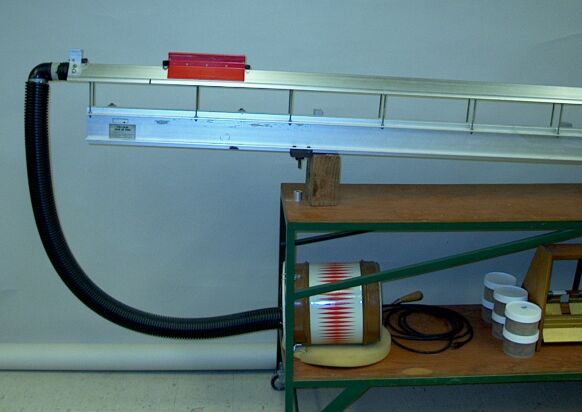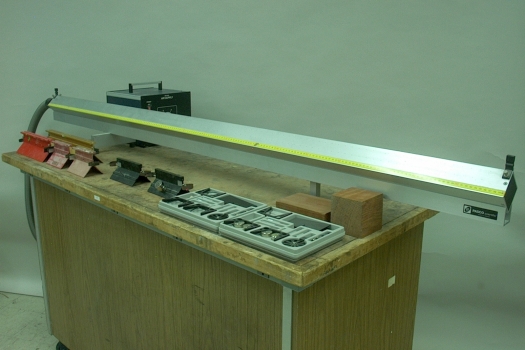 |
 |
 |
 |
You can tilt the air track at various angles to demonstrate uniform acceleration. For the Ealing air track (above, left), you can place the block under the rail in three orientations. For the PASCO air track (above, left), you can use the small or large block, or both, under either the foot or the rail, in different orientations.
The Ealing air track at left is 3.8 meters long. Though it is possible to use it in both lecture halls 1610 and 1640, in 1640 the smaller PASCO unit at right, which is 2 m long, is probably more convenient.
In demonstration 08.03 -- Level air track, the only force that acts on the glider in the direction of its motion, is the impulse that you give it with your hand (and, of course, the impulse of the springs at either end of the glider when it reaches the stop at either end of the track). Gravity, since it acts along a line perpendicular to the track, has no component in the direction of motion. For this demonstration, you tilt the air track to some angle, θ, relative to the horizontal, so that the gravity is no longer perpendicular to the track. Gravity now has a component, mg sin θ, parallel to the track, and thus imparts a constant acceleration (equal to g sin θ) to the glider. Thus, when you release the glider from rest, its velocity increases linearly with time as it proceeds down the track. The greater the angle at which you tilt the track, the greater the acceleration. You can also show, by releasing gliders of different mass (to do this with the PASCO gliders, you add slugs to them), that this acceleration is the same for all the gliders, independent of mass. The gliders on the Ealing track have lengths such that their masses are in ratios of 1:2:3. Each of the PASCO gliders has a mass of 190 g, and you can add 50-g slugs in pairs, to give them a mass of 290 g or 390 g.
Whereas demonstration 08.03 illustrates linear motion at constant velocity, this demonstration shows linear motion at constant acceleration, which as noted above is g sin θ for all gliders, where θ is the angle to which you have raised the track relative to horizontal. We can refer to this acceleration as a. (The acceleration is a vector pointing in the direction of the track, but for simplicity, we will express it, velocity and position as scalars.) The acceleration is the time rate of change of the velocity, or a = dv/dt, so that if the initial velocity of the glider is v0 at some reference time, then its velocity at any time is
v = v0 + at
where t is the time elapsed since that reference time. The velocity, v, is the time rate of change of position, or v = dx/dt, so that if the initial position and velocity of the glider are x0 and v0 at some reference time, then its position at any time is
x = x0 + v0t + (1/2)at2
where t is the time elapsed since that reference time.
Since the acceleration is constant, the average velocity for any time interval, t, is
vave = (1/2)(v0 + v)
where v0 is the velocity at the beginning of the interval and v is the velocity at the end of the interval. As a result, we can add the following to the equations above:
x = x0 + (1/2)(v0 + v)t
From the first equation, we find t = (v - v0)/a, and if we substitute this for t in the last equation above, we obtain
v2 = v02 + 2a(x - x0)
References:
1) Resnick, Robert and Halliday, David. Physics, Part One, Third Edition (New York: John Wiley and Sons, 1977), pp. 38-40.